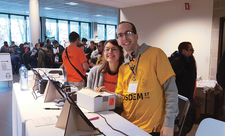FOSDEM 2017
Equilibrium

Long lines and interesting discussions awaited the visitor at this year's FOSDEM event in Brussels, Belgium.
Apparently, not even the FOSDEM team can guess which topics will attract a large audience and which will not, despite many years of experience. The result: Long lines formed before some rooms at FOSDEM'17, the largest European FOSS community event, which was held in early February 2017.
The fast campus LAN closed the breach for those waiting in line this time, however. The organizers broadcast live streams of presentations from all rooms by building their own content delivery network, proving that FOSDEM is in good shape in terms of hardware. Many of the videos are now online [1].
Buses and trains were running again, in contrast with the previous year, but visitors seem to like FOSDEM the way it is – including the beer event on the evening before the headliner. The organizers can only roughly estimate the number of visitors (about 8,000) because they do not sell tickets.
[...]
Buy this article as PDF
(incl. VAT)
Buy Linux Magazine
Subscribe to our Linux Newsletters
Find Linux and Open Source Jobs
Subscribe to our ADMIN Newsletters
Support Our Work
Linux Magazine content is made possible with support from readers like you. Please consider contributing when you’ve found an article to be beneficial.

News
-
Another Linux Malware Discovered
Russian hackers use Hyper-V to hide malware within Linux virtual machines.
-
TUXEDO Computers Announces a New InfinityBook
TUXEDO Computers is at it again with a new InfinityBook that will meet your professional and gaming needs.
-
SUSE Dives into the Agentic AI Pool
SUSE becomes the first open source company to adopt agentic AI with SUSE Enterprise Linux 16.
-
Linux Now Runs Most Windows Games
The latest data shows that nearly 90 percent of Windows games can be played on Linux.
-
Fedora 43 Has Finally Landed
The Fedora Linux developers have announced their latest release, Fedora 43.
-
KDE Unleashes Plasma 6.5
The Plasma 6.5 desktop environment is now available with new features, improvements, and the usual bug fixes.
-
Xubuntu Site Possibly Hacked
It appears that the Xubuntu site was hacked and briefly served up a malicious ZIP file from its download page.
-
LMDE 7 Now Available
Linux Mint Debian Edition, version 7, has been officially released and is based on upstream Debian.
-
Linux Kernel 6.16 Reaches EOL
Linux kernel 6.16 has reached its end of life, which means you'll need to upgrade to the next stable release, Linux kernel 6.17.
-
Amazon Ditches Android for a Linux-Based OS
Amazon has migrated from Android to the Linux-based Vega OS for its Fire TV.

